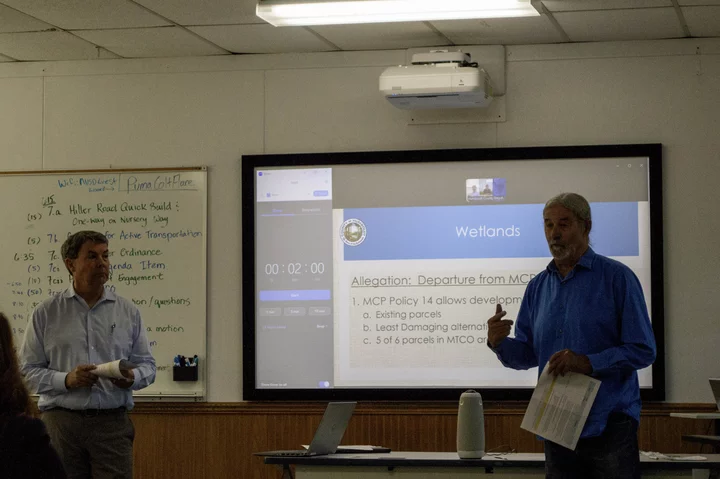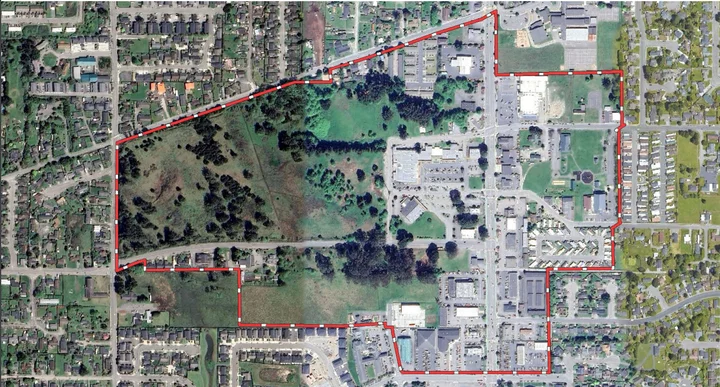John Ford (left) and Steve Madrone (right) at last night’s MMAC meeting. By Dezmond Remington.
County Supervisor Steve Madrone and Humboldt County’s Planning and Building Director John Ford addressed concerns and refuted misinformation about the McKinleyville Town Center Project at a standing-room-only meeting of the McKinleyville Municipal Advisory Committee (MMAC) last night.
The Town Center Project is a proposed development project that would add blocks of pedestrian and cyclist-focused retail and housing space to McKinleyville, as well as a park and other outdoor amenities, as a way to add a central hub to a sprawling, suburban town.
The MMAC didn’t end up voting on approving a draft Environmental Impact Report (EIR) or the draft ordinance at this meeting, instead kicking it to the next meeting on July 30.
It’s contentious. The draft EIR runs over 1,000 pages, giving both detractors and advocates plenty of material to complain about. Ford and Madrone talked for hours about the community’s concerns, and even distributed a six-page leaflet created by the building department addressing many of them.
Wetlands are one of the community’s main concerns, taking up about one page out of 12 on a letter addressed to Ford penned by a group of concerned citizens.
Defining what, exactly, constitutes a wetland is almost straightforward. There are what are called three-parameter wetlands (basically: the land is water-logged, supports wetland vegetation, and is composed of soils unique to wetlands), and there are single-parameter wetlands that only need the wetland soils to count as a wetland. Different agencies use different standards. The Town Center Ordinance uses the three-parameter standard.
According to Ford, they found about 0.64 acres of single-parameter wetland on the property spread out over four chunks on the western side. It’s currently being grazed by animals and maintained by lawnmowers. Fourteen acres of that has been set aside to make a park that would also include a grove of spruce trees.
By law, any wetlands developers fill in must be replaced at a ratio of 1.5 to 1; if one square foot of wetlands is filled in, it’ll be replaced by a foot and a half. Madrone said the best sections of wetlands would be preserved and linked together to form one “high-value” wetland, with a stream.
A map of the 134-acre McKinleyville Town Center site.
Commenters at the meeting and online also demanded that there be an affordable housing requirement if developers want to build on the property. So far, the only planned development on the parcel is a senior citizen community called Life Plan Humboldt, but its zoning requirements could total over 2,500 housing units and 900,000 square feet of retail and office space.
In an interview with the Outpost today, Ford said the planning department would likely take the step of including some affordability requirements in the zoning laws, which he said was a little unusual but made sense to do if people wanted it.
The McKinleyville Town Center project has been on McKinleyville’s Community Plan since 2002, but community members and government officials didn’t start drafting an ordinance that would shape how it looks and operates until 2019. The project site is mostly located west of Central Avenue on 134 acres (owned by Anne Pierson, descendant of Pierson’s Building Supply founder and totem pole constructor Ernest Pierson) behind the McKinleyville Shopping Center, though a small chunk extends east across Central and envelops Pierson Park.
It’s a big space, and those 2,500-something housing units could fit over 6,000 people. It would be a huge increase for McKinleyville (population 16,000), and the 36% increase was bandied about a few times.
Some commenters also didn’t like the idea that the Town Center could be made up of four-story buildings, which they thought was too high. Others, such as the Coalition for Responsible Transportation Priorities’ president Colin Fiske, said they were disappointed buildings wouldn’t be built to the full 75 foot height its zoning allows.
Madrone reminded people that any increase would happen gradually over the course of several decades, and that Humboldt County was still dealing with a housing crisis and affordability issues.
“This is not easy stuff, right?” Madrone said. “Nobody’s, like, ‘Oh yeah, let’s just grow the town by 36%.’ A lot of people [think] we already grew too fast. A lot of housing has been put into the community, but it’s been single family housing that’s spread out. We have a little bit of land left; we’re going to keep doing that? Are we going to do a little bit of stuff [vertically] up and create a vibrant town center?”
Ford said he was grateful for the comments and looked forward to developing the ordinance further.
“No process is perfect,” Ford said. “No ordinance will ever be perfect, but this has been an intentional desire to engage the community in a discussion about what’s important in the town center. There are people whose fingerprints are on it — even some people who feel like they haven’t been heard.”


CLICK TO MANAGE